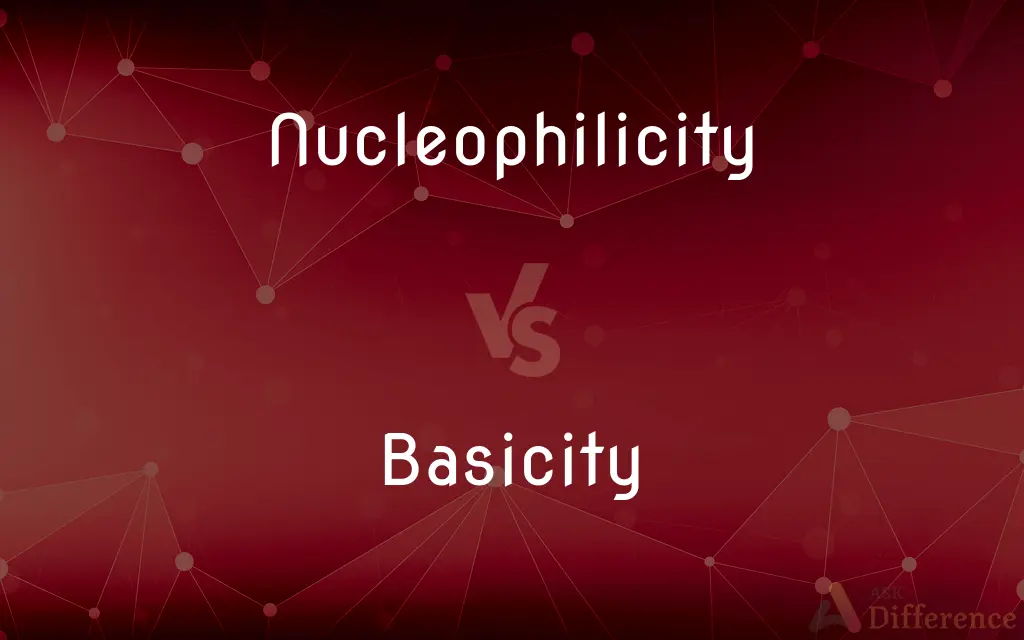Nucleophilicity vs. Basicity — What's the Difference?
By Fiza Rafique & Maham Liaqat — Updated on May 14, 2024
Nucleophilicity refers to the rate at which a molecule donates electrons to a positively charged atom; basicity measures a molecule's ability to accept a proton (H+).

Difference Between Nucleophilicity and Basicity
Table of Contents
ADVERTISEMENT
Key Differences
Nucleophilicity is a kinetic property, indicating how quickly a species can donate a pair of electrons to an electrophile (usually a carbon atom in organic chemistry). On the other hand, basicity is a thermodynamic property that measures how effectively a species can accept a proton from acids.
Nucleophiles are often involved in chemical reactions where they form new bonds with electrophiles. Whereas, bases are typically involved in reactions where they neutralize acids by taking a proton to form water and a salt if the acid is inorganic.
The solvent can greatly influence nucleophilicity; for example, in polar protic solvents, nucleophilicity decreases down a group on the periodic table. Conversely, basicity generally increases down a group regardless of the solvent, as it is more dependent on the stability of the base when it gains a proton.
Nucleophilicity can vary among different molecules depending on their electron density and the presence of electron-donating or withdrawing groups. On the other hand, basicity is primarily influenced by the stability of the conjugate acid formed when the base accepts a proton.
Certain molecules might exhibit high nucleophilicity and low basicity or vice versa, depending on their molecular structure and the reaction environment. For instance, a strong base might be a poor nucleophile in a highly protic solvent due to protonation.
ADVERTISEMENT
Comparison Chart
Definition
Rate of electron pair donation to an electrophile.
Ability to accept a proton.
Property Type
Kinetic
Thermodynamic
Influenced by
Solvent, electron density, steric effects.
Conjugate acid stability, solvent.
Typical Reaction
Forms new bonds with electrophiles.
Neutralizes acids, forms water and salts.
Example
An amine attacking a carbonyl carbon in ketones.
Ammonia accepting a proton to form ammonium ion.
Compare with Definitions
Nucleophilicity
Dependent on solvent and molecular structure.
In polar protic solvents, iodide is more nucleophilic than fluoride.
Basicity
A measure of a molecule's proton affinity.
The basicity of hydroxide ions makes them effective in neutralizing acids.
Nucleophilicity
A measure of a molecule's ability to donate electrons to an electrophile.
The sulfhydryl group in thiols is more nucleophilic than hydroxyl in alcohols.
Basicity
Determined by the stability of the conjugate acid.
The conjugate acid of ammonia, ammonium, is relatively stable, indicating good basicity.
Nucleophilicity
Influenced by electron density and steric factors.
Bulkier nucleophiles are less effective in crowded reaction centers.
Basicity
Affects the pH of solutions.
Adding a base like sodium hydroxide to water increases the pH.
Nucleophilicity
Important in SN1 and SN2 reaction mechanisms.
Ethoxide is a strong nucleophile that readily participates in SN2 reactions.
Basicity
Can be quantified by pKa values of the conjugate acid.
The lower the pKa of the conjugate acid, the stronger the base.
Nucleophilicity
Varies within the same molecule based on active sites.
The nitrogen in an amide is less nucleophilic due to resonance stabilization.
Basicity
Independent of reaction mechanism.
Basicity is a factor in acid-base reactions, not typically in nucleophilic substitutions.
Nucleophilicity
(uncountable) The condition of being nucleophilic
Basicity
Of, relating to, or forming a base; fundamental
“Basic changes in public opinion often occur because of shifts in concerns and priorities” (Atlantic).
Nucleophilicity
(countable) A measure of the extent to which something is nucleophilic, or of the reactivity of such a reagent
Basicity
Of, being, or serving as a starting point or basis
A basic course in Russian.
A set of basic woodworking tools.
Basicity
Of or relating to a base.
Basicity
Containing a base, especially in excess of acid.
Basicity
Alkaline.
Basicity
(Geology) Containing little silica, as certain igneous rocks.
Basicity
(Slang) Unthinkingly or blandly conformist
“Even someone who looks really indie … can be basic if they are simply imitating others rather than thinking for themselves” (Chelsea Rickling).
Basicity
An essential, fundamental element or entity
The basics of math.
Basicity
Basic training.
Basicity
(uncountable) The condition of being basic.
Basicity
The degree to which a substance is basic: its pH level.
Basicity
The number of replaceable hydrogen atoms in a molecule of an acid.
Basicity
The quality or state of being a base.
Common Curiosities
What is nucleophilicity?
Nucleophilicity measures how quickly a species donates electrons to an electrophile in a reaction.
What defines basicity?
Basicity is the ability of a species to accept a proton, typically measured by the stability of the resulting conjugate acid.
Does molecular size affect nucleophilicity?
Yes, larger molecules or those with bulky groups near the reactive site can exhibit reduced nucleophilicity due to steric hindrance.
Why is nucleophilicity important in organic chemistry?
Nucleophilicity is crucial for understanding and predicting the outcomes of many organic reactions, particularly those involving substitutions and additions.
What role does basicity play in acid-base reactions?
Basicity determines how effectively a base can neutralize an acid, important in processes like buffering and pH regulation in chemical and biological systems.
How are nucleophilicity and basicity measured?
Nucleophilicity is generally not measured directly but inferred from reaction rates, while basicity can be quantitatively assessed using the pKa of the conjugate acid.
Are there exceptions to trends in nucleophilicity and basicity?
Yes, specific molecular structures and unusual electronic effects can lead to deviations from typical trends in both properties.
Can a molecule be both a good nucleophile and a strong base?
Yes, a molecule can be both, depending on its electron density and the environment, although some good nucleophiles are poor bases in certain solvents, and vice versa.
What is the difference between a nucleophile and a base?
A nucleophile donates electron pairs to electrophiles to form chemical bonds, while a base accepts protons from acids, primarily involved in acid-base reactions rather than forming covalent bonds.
How does solvent affect nucleophilicity and basicity?
Solvent impacts nucleophilicity significantly, especially in polar protic solvents where it can enhance or reduce a nucleophile's effectiveness. Basicity is less affected by the solvent but can influence the dissociation of the base into its conjugate acid.
Share Your Discovery

Previous Comparison
Hypospadias vs. Epispadias
Next Comparison
Chartered vs. CertifiedAuthor Spotlight
Written by
Fiza RafiqueFiza Rafique is a skilled content writer at AskDifference.com, where she meticulously refines and enhances written pieces. Drawing from her vast editorial expertise, Fiza ensures clarity, accuracy, and precision in every article. Passionate about language, she continually seeks to elevate the quality of content for readers worldwide.
Co-written by
Maham Liaqat















































